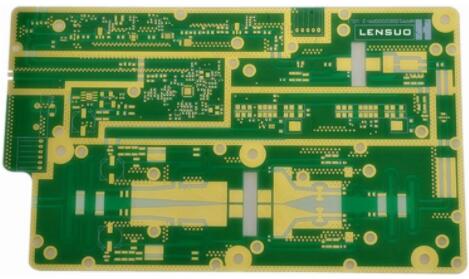Difficulties in processing high-frequency microwave panels
Based on the physical and chemical properties of the PTFE board, its processing technology is different from the traditional FR4 process. If it is processed under the same conditions as the conventional epoxy resin glass fiber copper clad laminate, qualified products cannot be obtained.
1) Drilling: The base material is soft, and the number of stacked plates for drilling should be small. Usually 0.8mm plate thickness is suitable for two stacks; the speed should be slower; to use a new drill bit, the top angle and thread angle of the drill bit have their own characteristics. special request.
2) Printed solder mask: After the board is etched, the board cannot be polished with a roller brush before the solder mask is printed, so as not to damage the substrate. It is recommended to use chemical methods for surface treatment. To achieve this: without grinding the board, after printing the solder mask, the circuit and the copper surface are uniform and there is no oxide layer, which is by no means easy.
3) Hot air leveling: Based on the inherent properties of fluororesin, rapid heating of the sheet should be avoided as much as possible. Before spraying tin, preheat treatment at 150°C for about 30 minutes, and then spray tin immediately. The temperature of the tin tank should not exceed 245 degree Celsius, otherwise the adhesion of the isolated pad will be affected.
4) Milling profile: The fluororesin is soft, the general milling cutter has a lot of burrs, and it is uneven, and it needs to be milled with a suitable special milling cutter.
5) Transport between processes: It cannot be placed vertically, only placed in the basket flat with paper, and no finger is allowed to touch the circuit pattern in the board during the whole process. The whole process prevents scratches and scratches. Line scratches, pinholes, indentations, and dents will affect signal transmission, and the board will be rejected.
6) Etching: Strictly control side erosion, sawtooth, and notch, and strictly control the line width tolerance of ±0.02mm. Check with a 100x magnifying glass.
7) Electroless copper deposition: The pretreatment of electroless copper deposition is a difficult and critical step in the manufacture of Teflon boards. There are many methods for pretreatment of copper sinking, but in summary, there are two methods that can stabilize the quality and are suitable for mass production:
Method 1: Chemical method: Add a solution such as tetrahydrofuran to form a sodium tetrafluoroethylene complex, so that the surface atoms of the polytetrafluoroethylene in the pores are eroded to achieve the purpose of wetting the pores. This is a classic and successful method with good results and stable quality, but it is highly toxic, flammable, and dangerous, and requires special management.

Method 2: Plasma (plasma) method: Imported equipment is required, and carbon tetrafluoride (CF4) or argon (Ar2) nitrogen (N2) and oxygen are injected between two high-voltage power supplies in a vacuumed environment (O2) gas, the printed board is placed between the two electricity, plasma is formed in the cavity, so as to remove the dirt and dirt in the hole. This method can obtain a satisfactory uniform effect, and mass production is feasible. But to invest in expensive equipment (approximately more than one hundred thousand US dollars per machine), there are two well-known Plasma equipment companies in the United States: APS and March.
In recent years, some domestic documents have also introduced many other methods, but the classic and effective methods are the above two.
For ε3.38 and Rogers Ro4003 high-frequency substrates, it has the same high-frequency performance as the PTFE glass fiber substrate and the easy processing characteristics similar to the FR4 substrate. This uses glass fiber and ceramics as fillers, and the glass transition temperature High heat-resistant material with Tg>280 degree Celsius. This kind of substrate drilling consumes a lot of drill bits and requires special drilling machine parameters. The milling profile needs to be changed often; but other processing techniques are similar, and no special hole treatment is required, so it has been recognized by many PCB manufacturer and customers. But Ro4003 does not contain flame retardant, the board reaches 371 degree Celsius, the board can cause burning. State-owned 704 factory LGC-046 sheet is a modified polyphenylene ether (PPO) type, with a dielectric constant of 3.2 and processing performance as FR4. This product has also been approved for use in many domestic orders.